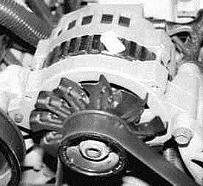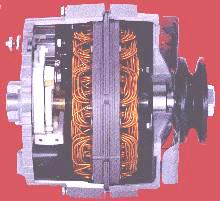

Alternator mounted on engine and cut away view.
AutoTips Alternator Page


Alternator mounted on engine and cut away view.
Alternator:
What it does: Supply
current to charge the battery and run the electrical components of a vehicle.
Typical Failures: Low or no output. Failures can be due to:
Quick Troubleshooting if you suspect the alternator has low output.
When you go to buy a replacement:
Ratings: Alternators
are rated for a current output capacity (such as 50 amps or 90 amps ) at
a specific RPM , and physical size (normally by car model and year). If
you are fortunate enough to have a factory service manual, you may be able
to find a table of specifications that indicates the proper rating for
your vehicle. Sometimes you may find a rating on the alternator. In most
cases, the auto parts store will have a listing for your car.
Pulley: Because the same alternator is used on many models, the pulley on the alternator at the store listed for your car may not match the one on the current alternator. Pulleys are not always easy to remove, however many of the parts stores have the proper tools and can swap pulleys for you if you take your old alternator in.
How it works: A current through the rotor supplied by the battery
generates a magnetic field as the alternator spins. The magnetic field
cuts through coils of wire and generates a current. The regulator monitors
the battery voltage, and varies the current that generates the magnetic
field, thus regulating the current that is charging the battery. As the
voltage of the battery approaches full charge, the regulator cuts back
on the output of the alternator. An alternator can not start charging with
a 100% dead battery, although once going, it sometimes can generate an
output if the battery is removed. Never try this, the voltage from the
alternator can rise, and damage the vehicle's electrical system.
Return to AutoTips home page Return to the AutoTips underhood page.